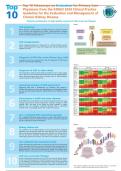Other
Top 10 Takeaways on Evaluation for Primary Care Physicians from the KDIGO 2024 Clinical Practice Guideline for the Evaluation and Management of Chronic Kidney Disease
Top 10 Takeaways on Evaluation for Primary Care Physicians from the KDIGO 2024 Clinical Practice Guideline for the Evaluation and Management of Chronic Kidney Disease
[Show more]



